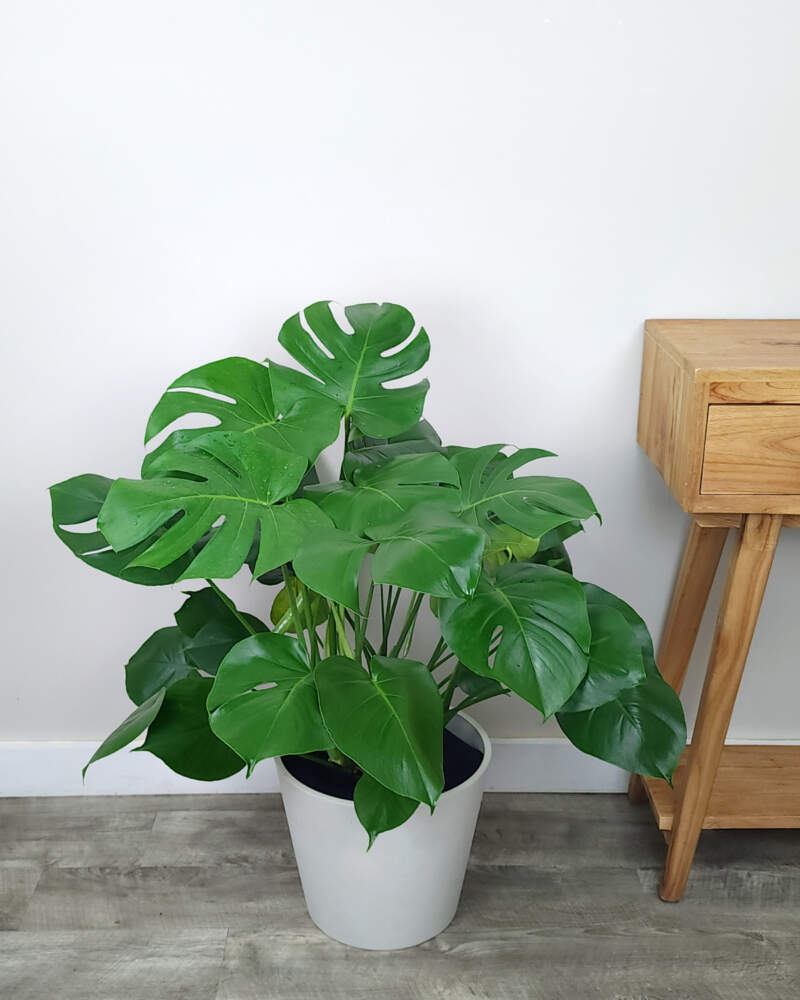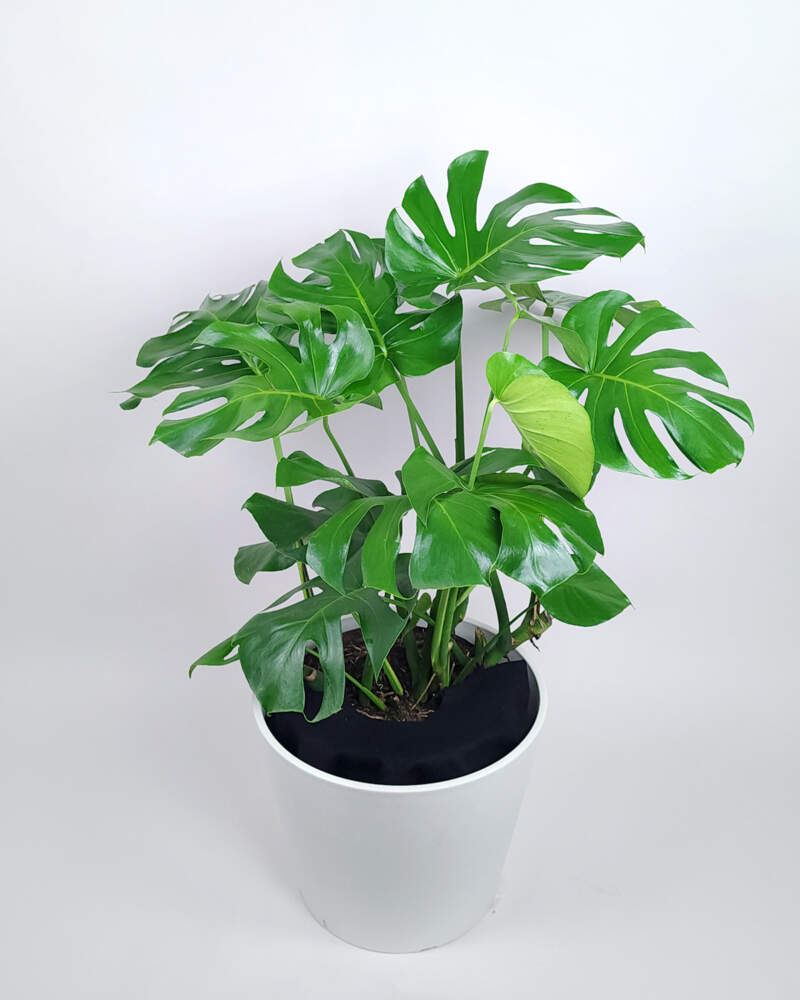Monstera Mash Plant: Tips for Growing and Caring for Monstera adansonii

Monstera Mash plant, commonly known as the "Swiss cheese plant" or Monstera Adansonii Plant, is a remarkable and low-maintenance vine houseplant.
Its distinctive heart-shaped leaves with prominent holes give it a charming and unique appearance.
This comprehensive guide offers valuable tips and information on Monstera adansonii care to help you successfully grow and nurture your Monstera Mash Plant.
Key Features:
Scientific Name: Monstera deliciosa
Alternative/English Names: Swiss Cheese Plant, Mexican Breadfruit, Fruit Salad Plant
Color: Green leaves with natural fenestrations (holes) and cream-colored sheaths
Taste: The edible fruit has a sweet, pineapple-like flavor
Height: Can reach up to 20 feet (6 meters) in ideal conditions
Spread: 3-5 feet (0.9-1.5 meters)
What is Monstera Mash Plant?
The Monstera deliciosa, commonly known as the Swiss Cheese Plant or Mexican Breadfruit, is a stunning and iconic tropical plant prized for its unique foliage.
Its large, glossy leaves are characterized by natural perforations or fenestrations, giving them a distinctive Swiss cheese-like appearance. These holes develop as the plant matures, adding to its visual appeal.
Beyond its striking foliage, the Monstera deliciosa is also valued for its edible fruit, which resembles a green corn cob and can reach up to 2 feet (0.6 meters) in length when fully grown. The fruit has a sweet, pineapple-like flavor and is a popular ingredient in various tropical cuisines.
While the fruit is edible, it is important to note that the plant's stems and leaves contain calcium oxalate crystals, which can cause skin irritation, mouth discomfort, and digestive issues if ingested. Therefore, it is recommended to exercise caution and avoid consuming any part of the plant other than the ripe fruit.
The Monstera deliciosa is a popular choice for indoor gardening and can thrive in various environments, making it a beloved addition to homes, offices, and conservatories. Its lush foliage and unique appearance add a tropical flair to any space, making it a true showstopper among houseplants.
Growing Conditions for Monstera Mash Plant:
Lighting:
Monstera adansonii thrives in bright, indirect sunlight.
Placing your Monstera Mash Plant near a window with access to bright indirect light will result in bigger leaves and faster growth.
Temperature:
Maintain a temperature range of 65-85°F (18-29°C) for optimal growth of your Monstera Mash Plant.
Humidity:
Monstera Mash Plant prefers humidity levels between 60% and 80%.
Consider using a humidifier or misting the leaves occasionally to provide adequate humidity.
Watering:
Water your Monstera adansonii moderately and consistently, allowing the top inch of soil to dry out between waterings.
Avoid overwatering, as it can lead to root rot.Soil:
Use a well-draining potting mix consisting of peat moss, perlite, and compost to ensure proper moisture retention while allowing excess water to escape.

Propagation and Repotting:
- Select a healthy stem with at least two leaf nodes for propagation.
- Make a clean cut just below a leaf node using clean pruning shears or scissors.
- If desired, dip the cut end in rooting hormone powder.
- You can propagate the cutting in water or moist soil.
- Provide adequate light and warmth for root development.
- Change the water every few days for water propagation, or keep the soil consistently moist for soil propagation.
- It may take weeks for roots to develop, so provide adequate light and warmth while monitoring the cutting.
- Transplant it into a well-draining pot with proper soil once the cutting has developed roots.
Repotting:
Repot in spring or early summer, use a slightly larger pot with drainage holes, and handle the plant gently.
Post-repotting care:
Place the plant in bright indirect light, avoid direct sunlight initially, water lightly, and monitor for any signs of stress or overwatering.
Caring for Monstera Mash Plant:
- Place your Monstera adansonii near a window, where it can access to bright indirect light.
This will make it grow faster and healthy
- Water your Monstera Mash Plant when the top inch of soil feels dry, avoiding overwatering.
- Mist the leaves occasionally to increase humidity.
- Fertilize the plant monthly during the growing season.
Use ¼ diluted complete liquid fertilizer or ¼ diluted fish emulsion twice a month.
- This plant is a climber, so it might need to be pruned before it begins to outgrow the space it’s in.
Pruning should be done during spring with sterile pruning shears, and cut-back stems no more than 25%.
Common Problems and Solutions for Monstera Mash Plant:
Yellowing leaves and brown spots
This indicates overwatering, underwatering, nutrient deficiencies, or excessive sunlight.
Solution:
Adjust watering practices, evaluate lighting conditions, and address nutrient deficiencies with a balanced houseplant fertilizer.
Root rot:
can occur due to overwatering or poor drainage.
Solution
Trim affected roots, repot in fresh soil with proper drainage, and adjust watering practices to prevent future root rot.Pest and Diseases:
Watch for common houseplant diseases and pest such as powdery mildew, root rot, blight, and rust. Identify the pests, isolate the affected plant.
Solution:
manually remove pests, apply insecticidal soap or neem oil, and maintain plant health through proper care.
Monstera Adansonii Toxicity
According to the ASPCA, all Monstera plants are toxic, so it’s best to keep them out of reach of children and pets.
Take safety measures when placing your Swiss cheese plant at home.
Ingestion can cause irritation, excessive drooling, mouth swelling, vomiting, and difficulty swallowing.

Conclusion:
Congratulations! You now have the knowledge and tools to embark on your Monstera Mash plant journey.
Remember to provide the optimal growing conditions, propagate with care, and maintain regular care and maintenance.
With their captivating foliage and air-purifying benefits, Monstera Mash plants are sure to elevate the beauty of your indoor or outdoor space.
So, why wait? Start growing your own Monstera Mash plant today and experience the joy of nurturing this stunning foliage!
Frequently Asked Questions (FAQs)
Q: Can I place my Monstera plant in direct sunlight?
A: While some direct morning or evening sunlight can be beneficial for growth, avoid placing your Monstera in intense, direct sunlight as it can scorch the leaves. Opt for bright indirect light instead.
Q: How do I propagate my Monstera plant?
A: To propagate your Monstera, select a healthy stem with aerial roots and cut just below a node. Place the cutting in water or moist soil until roots develop, then transfer it to a pot with well-draining soil.
Q: My Monstera leaves are turning yellow. What should I do?
A: Yellowing leaves can indicate overwatering or underwatering. Check the moisture level of the soil and adjust your watering routine accordingly. Ensure proper drainage to prevent root rot.
Q: Is the Monstera plant poisonous?
A: Monstera is mildly toxic to humans and is toxic to cats and dogs but is not considered lethal. All parts of the plant are harmful to ingest except the fully ripe fruit, which rarely develops on indoor Monstera. The toxicity comes from insoluble oxalate crystals in the juices inside the plant.
Q:Where is the best place to put a Monstera deliciosa?
A:Monstera deliciosa prefers bright, indirect light, so give it a spot a few feet away from a southern, western, or eastern-facing window. It can tolerate some shade, but too much shade will make it leggy
